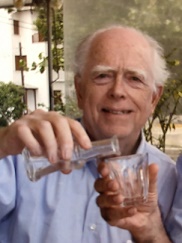
John Edward Casida
Professor of Environmental Science, Policy & Management
John Edward Casida, one of the world’s leading experts on pesticide chemistry and physiology, died on June 30, 2018. He had served on the University of California, Berkeley, faculty for 58 years. He was the Edward A. Dickson Professor Emeritus in the Department of Environmental Science, Policy & Management, and earlier held the Maurice Hoskins Chair in the Department of Entomology. Among his many awards were the Wolf Prize in Agriculture, membership in the U.S. National Academy of Sciences and the Royal Society of the United Kingdom, and he was the Martin Meyerson Berkeley Faculty Research Lecturer 1997-1998. In 2005, he became an honorary member of the Pesticide Science Society of Japan to whose establishment in 1975 he had contributed immensely.
His research interests were broad including not only how pesticides kill insects but also how they affect other animals, including us, and the environment. Much of his research centered on understanding the mode of action of insecticides as a basis for evaluating the risk of pesticides and other toxicants, which was essential to the development of safer and more effective tools in agricultural pest management. He and his colleagues formulated several new compounds that were more active and less persistent than many agricultural chemicals. Throughout his career he made many fundamental breakthroughs by integrating the fields of entomology, neurobiology, toxicology, and biochemistry.
John was born in Tempe, AZ (part of metropolitan Phoenix) on December 22, 1929. His father, Lester Earl Casida, was then teaching in a one-room schoolhouse before going on to complete his graduate education and beginning a career as a professor of animal science at the University of Wisconsin, Madison. His mother was Ruth Barnes Casida. Like most entomologists, John became interested in entomology by collecting insects and observing their fascinating behaviors when he was young. He was an Eagle Scout (and later a scoutmaster in Berkeley). Because many students had gone off to World War II, he was able to work part-time as a technician in various agricultural laboratories at the University of Wisconsin when he was barely a teenager!
He attended the University of Wisconsin, Madison, as an undergraduate and a graduate student where he combined studies in entomology, biochemistry, and plant physiology to understand the interactions of insects and their chemical deterrents and attractants. While an undergraduate, he was captain of the fencing team and won a bronze medal at the National Collegiate Athletic Association championships. He published his first article in the journal Science when he was 22.
Before he completed his Ph.D. in 1954, John’s studies were interrupted by the Korean War. As a young lieutenant, he was assigned to chemistry labs at Fort Dietrich, MD, and he also took coursework at the University of Maryland. After returning to Madison and completing his doctoral degree, he joined the Department of Entomology as an assistant professor in 1954. He directed the Pesticide and Toxicology Laboratory until he left Madison to accept a position at Berkeley in 1964. He said that he chose to come to the Department of Entomology at Berkeley because it was not only the best entomology department in the world but because three of the famous entomologists there at the time—Ray Smith, Robert Usinger, and Gordon Linsley—were excellent salesman in getting him to join the faculty!
At Berkeley, he continued his research, and by the end of his career had published well over 800 scientific articles, many of which were cited over 1,000 times. He also held 31 patents. For 67 years, he taught an undergraduate course on pesticide chemistry and toxicology at Madison and Berkeley.
The Environmental Chemistry and Toxicology Laboratory that he established at Berkeley was the home for 63 Ph.D. students and more than 160 postdoctoral researchers and visiting scholars from all over the world. Many of these were repeat visitors, and former students often sent their students to him for training, making him a grand-academic parent. He often told people that asked about his most significant research was that it was the last project he finished or the next one he was beginning.
His laboratory experienced all of the tumult of Berkeley activities. In 1969, during the People’s Park demonstrations, gas masks were stolen from his lab at a faster rate than could be replaced. He was later a target of the Animal Rights movement and his home was picketed.
His wife Kati is a well-known Berkeley artist, whose most visible art is a large ironwork sculpture at Cesar Chavez Park in Berkeley, which was placed adjacent to San Francisco Bay. John was very proud of Kati’s art works and became very animated when describing them. John was the father of Mark and Eric, and had two grandchildren, Mariposa and Tenaya.
Several obituaries have commented on John’s research accomplishments but his nonacademic interests were impressive and he was an intriguing colleague. Quite private, he enjoyed playing an enigmatic role, often answering a question with a question. He had diverse hobbies ranging from collecting pre-Columbian artifacts to Greek dancing. He and Kati loved Greece and were deeply involved with the local Greek-American community. They visited Greece as often as possible. John was an excellent photographer, typically taking photos of people, and these were hung throughout the walls of his home and office. He was one of the very few scientists to be active in the Berkeley Arts Club.
One of the topics that John studied and that really demonstrated the breadth of his research interests was his work on absinthe—the mythical “green fairy” liquor that has been both praised and vilified for over 200 years. Through his research he described the mode of action of this drink, which provided a reasonable explanation for some of the reactions caused by absinthe but not by other alcoholic drinks.
Vincent H. Resh
Alexander H. Purcell III
David L. Wood
2020
